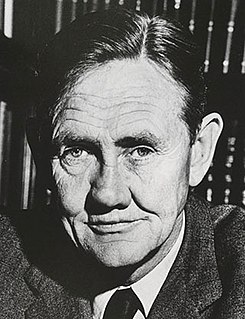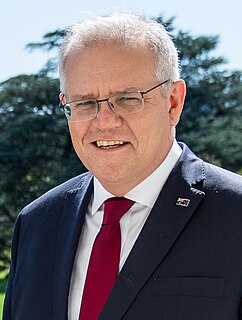Related Research Articles

The House of Representatives is the lower house of the bicameral Parliament of Australia, the upper house being the Senate. Its composition and powers are established in Chapter I of the Constitution of Australia.

The Senate is the upper house of the bicameral Parliament of Australia, the lower house being the House of Representatives. The composition and powers of the Senate are established in Chapter I of the Constitution of Australia. There are a total of 76 senators: 12 are elected from each of the six Australian states regardless of population and 2 from each of the two autonomous internal Australian territories. Senators are popularly elected under the single transferable vote system of proportional representation.

The Parliament of Australia is the legislative branch of the government of Australia. It consists of three elements: the Crown, the Senate and the House of Representatives. The combination of two elected chambers, in which the members of the Senate represent the states and territories while the members of the House represent electoral divisions according to population, is modelled on the United States Congress. Through both chambers, however, there is a fused executive, drawn from the Westminster system.
In the Parliament of Australia, a casual vacancy arises when a member of either the Senate or the House of Representatives:
The Constitution Alteration Bill 1977, was a successful proposal to alter the Australian Constitution concerning the filling of casual vacancies in the Senate. It was put to voters for approval in a referendum held on 21 May 1977. After being approved in the referendum, it received the royal assent and became law on 29 July 1977.
The separation of powers in Australia is the division of the institutions of the Australian government into legislative, executive and judicial branches. This concept is where legislature makes the laws, the executive put the laws into operation, and the judiciary interprets the laws; all independently of each other. The term, and its occurrence in Australia, is due to the text and structure of the Australian Constitution, which derives its influences from democratic concepts embedded in the Westminster system, the doctrine of "responsible government" and the United States version of the separation of powers. However, due to the conventions of the Westminster system, a strict separation of powers is not always evident in the Australian political system, with little separation between the executive and the legislature, with the executive required to be drawn from, and maintain the confidence of, the legislature; a fusion.

The politics of Australia take place within the framework of a federal parliamentary constitutional monarchy. Australia has maintained a stable liberal democratic political system under its Constitution, one of the world's oldest, since Federation in 1901. Australia is the world's sixth oldest continuous democracy and largely operates as a two-party system in which voting is compulsory. The Economist Intelligence Unit rated Australia a "full democracy" in 2021. Australia is also a federation, where power is divided between the federal government and the states and territories.

The 1972 Australian federal election was held in Australia on 2 December 1972. All 125 seats in the House of Representatives were up for election, as well as a single Senate seat in Queensland. The incumbent Liberal–Country coalition government, led by Prime Minister William McMahon, was defeated by the opposition Labor Party led by Gough Whitlam. Labor's victory ended 23 years of successive Coalition governments that began in 1949 and started the three-year Whitlam Labor Government.

The Court of Disputed Returns in Australia is a special jurisdiction of the High Court of Australia. The High Court, sitting as the Court of Disputed Returns, hears challenges regarding the validity of federal elections. The jurisdiction is twofold: (1) on a petition to the Court by an individual with a relevant interest or by the Australian Electoral Commission, or (2) on a reference by either house of the Commonwealth Parliament. This jurisdiction was initially established by Part XVI of the Commonwealth Electoral Act 1902 and is now contained in Part XXII of the Commonwealth Electoral Act 1918. Challenges regarding the validity of State elections are heard by the Supreme Court of that State as the State's Court of Disputed Returns.
Section 44 of the Australian Constitution lists the grounds for disqualification on who may become a candidate for election to the Parliament of Australia. It has generally arisen for consideration by the High Court sitting in its capacity as the Court of Disputed Returns. It has been reviewed several times, but has not been amended. Following several disqualifications under sub-section 44(i), a new review of the whole section was instituted on 28 November 2017.
This is a list of members of the Australian Senate from 1975 to 1978. The 13 December 1975 election was a double dissolution of both houses, with all 127 seats in the House of Representatives, and all 64 seats in the Senate up for election. Malcolm Fraser had been commissioned as prime minister following the dismissal of Gough Whitlam's Labor government by Governor-General Sir John Kerr, on 11 November 1975. The same day, Fraser advised the calling of the election, in accordance with Kerr's stipulated conditions. Thus the Liberal Party of Australia, led by Fraser, with Coalition partner the National Country Party, led by Doug Anthony, went to the election as a caretaker government. The election resulted in the Coalition securing government with a 30-seat swing away from Labor in the House of Representatives.
A by-election for the Australian House of Representatives division of Wills was held on 11 April 1992. It was triggered by the resignation of sitting Labor Party member and former Prime Minister Bob Hawke.

The Gorton Government was the federal executive government of Australia led by Prime Minister John Gorton. It was made up of members of a Liberal-Country Party coalition in the Australian Parliament from January 1968 to March 1971.

The Holt Government was the federal executive government of Australia led by Prime Minister Harold Holt. It was made up of members of a Liberal-Country Party coalition in the Australian Parliament from 26 January 1966 – 19 December 1967.

Section 24 of the Constitution of Australia is titled "Constitution of House of Representatives". It provides that the House of Representatives be "directly chosen by the people of the Commonwealth" and have twice as many seats as the Senate. It also provides a formula for the number of seats in each state, subject to later amendment by the parliament, and guarantees at least five members for each original state.

Blundell v Vardon, was the first of three decisions of the High Court of Australia concerning the 1906 election for Senators for South Australia. Sitting as the Court of Disputed Returns, Barton J held that the election of Anti-Socialist Party candidate Joseph Vardon as the third senator for South Australia was void due to irregularities in the way the returning officers marked some votes. The Parliament of South Australia appointed James O'Loghlin. Vardon sought to have the High Court compel the Governor of South Australia to hold a supplementary election, however the High Court held in R v Governor of South Australia; Ex parte Vardon that it had no power to do so. Vardon then petitioned the Senate seeking to remove O'Loghlin and rather than decide the issue, the Senate referred the matter to the High Court. The High Court held in Vardon v O'Loghlin that O'Loghlin had been invalidly appointed and ordered a supplementary election. Vardon and O'Loghlin both contested the supplementary election, with Vardon winning with 54% of the vote.

Sykes v Cleary was a significant decision of the High Court of Australia sitting as the Court of Disputed Returns on 25 November 1992. The case was a leading decision on Section 44 of the Constitution of Australia, dealing with both what constitutes an office of profit under the Crown and allegiance to a foreign power. The majority held that a teacher employed by the State of Victoria held an "office of profit under the Crown" within the meaning of s 44(iv) and so was "incapable of being chosen". A person who held dual citizenship was incapable of being chosen unless they had taken all reasonable steps to renounce the other citizenship.

Starting in July 2017, the eligibility of several members of the Parliament of Australia to be elected was questioned. Referred to by some as a "constitutional crisis", fifteen sitting politicians were ruled ineligible by the High Court of Australia or resigned pre-emptively. The situation arose from section 44(i) of the Australian Constitution, which prohibits parliamentarians from having allegiance to a foreign power, especially citizenship. On that basis, the High Court had previously held that dual citizens are ineligible for election unless they have taken "reasonable steps" to renounce the foreign citizenship before nomination.

Re Canavan; Re Ludlam; Re Waters; Re Roberts [No 2]; Re Joyce; Re Nash; Re Xenophon is a set of cases, heard together by the High Court of Australia sitting as the Court of Disputed Returns, arising from doubts as to the eligibility of a number of members of Parliament to be elected to Parliament because of section 44(i) of the Constitution.

The 2022 Australian federal election will be held on 21 May 2022 to elect members of the 47th Parliament of Australia.
References
- ↑ Constitution (Cth) s 43 Member of one House ineligible for other.
- ↑ Sykes v Cleary [1992] HCA 60 at 27, (1992) 176 CLR 77.
- ↑ Constitution (Cth) s 64 Ministers of State.